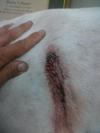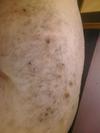Dog Skin Boils and Blisters
by Walter Stuart
(Sebring, FL)

This is an old blister
Reader Question on Dog Skin Boils and Blisters
I have an 8 year old American bulldog (bo). Bo is in good health but he is overweight. About 2 years ago he started having these blisters come up on his back. At first they would just scab up without much bleeding and leave a scar where the skin would not grow back.
We have been taking him to the vet and he would give us some antibiotics that would help, but not cure the problem. It has been steadily getting worse over the last year. We tried changing his food to a gluten free formula thinking that it might be allergies but no success.
Now it is getting to the point where the dog skin blisters and boils fill with a red pus like fluid that bursts and goes everywhere. These blisters and boils do look painful and he does itch them alot by rolling on his back.
Bo does seem to lick his paw alot and I have read that this means he might have allergies. We are stuck and would like to find out what this is so we can take care of it thanks.
Vet Suggestion Dog Skin Blisters and Boils
Hi Walter,
Your dog’s skin condition sounds quite severe. I am concerned that it has been going on for so long. He must be quite uncomfortable and could be at risk for secondary skin infections.
Usually the first step in cases like these is to run a few simple diagnostic tests, like a skin scraping for mange mites, skin cytology for bacterial and yeast infections, and a fungal culture for ringworm. I do still recommend that these tests be run if they haven’t already because they are so easy and (relatively) inexpensive, but my gut feeling is that skin biopsies are going to be needed to get to the bottom of your dog’s disease.
This procedure is not as involved as many owners think. It can usually be done under light sedation and local anesthesia, and the incisions closed with just a suture or two. The samples are then sent to a veterinary pathologist for evaluation, and if he or she can’t tell you exactly what is going on, it is usually possible to at least narrow down the list of potential problems and make a recommendation for what to do next.
Best of luck,
Jennifer Coates, DVM
Comments for Dog Skin Boils and Blisters
|
||
|
||
|
Click here to add your own comments Join in and write your own page! It's easy to do. How? Simply click here to return to Skin. |








